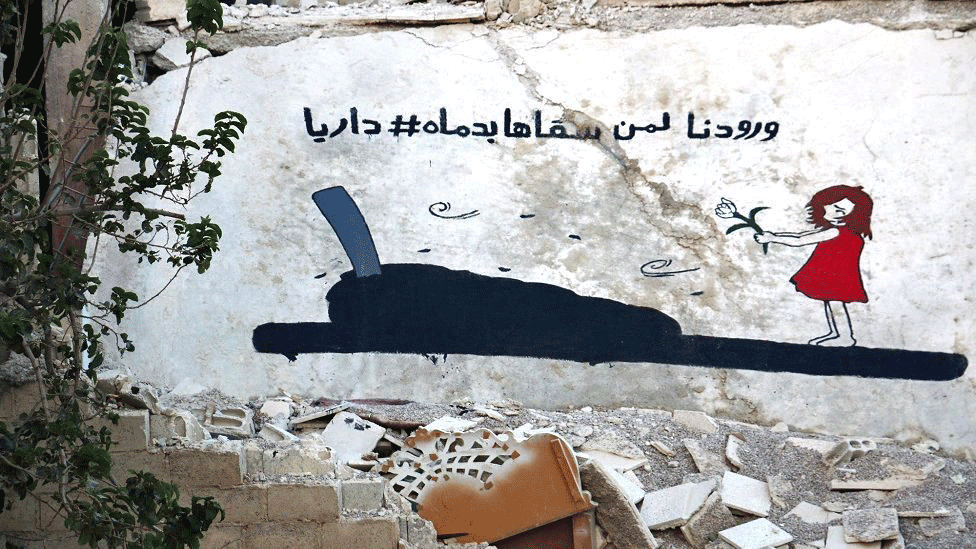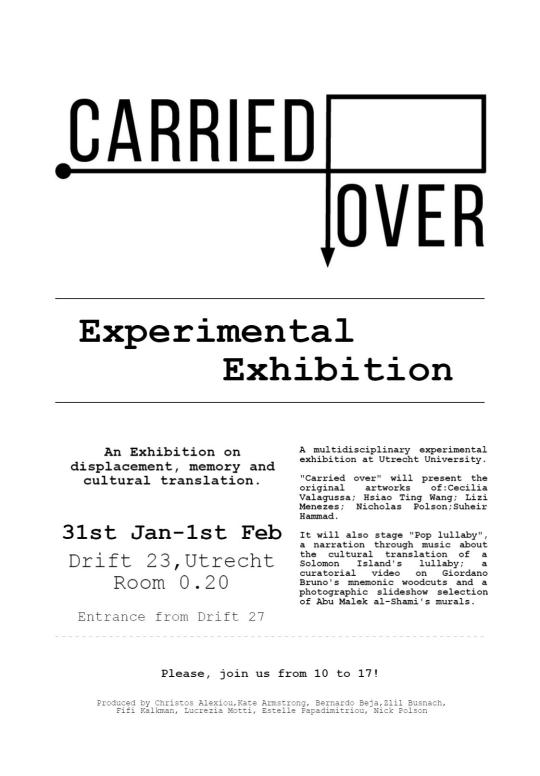Team project for the final assignment: “Carried over” an experimental multimodal exhibition on the themes of memory, displacement, and cultural translation (see reflections in week 3 and 4 for more info), accompanied by a designed catalogue with the curatorial descriptions.
Personally, it has been challenging to find an artwork to present to the exhibition and to come in contact with an art practitioner for the interview. As a matter of fact, after the winter break, I had to change both my proposals.
Interview:
In the beginning, I had the intention to interview the curator of MUDEC in Milan. I sent my first email to the museum the 15th December 2016, addressing directly the head of communication. Since I did not receive any answers, on the 22nd of December 2016 I tried to contact the press office of the museum.

Stefania Coltro, the contact for the press office, answered me immediately asking the themes of the interview so that she could contact the right person. I gave her the required information and I waited for her to write me back. My mistake has been to wait without having a valid second alternative. As a matter of fact, after the winter break, I sill did not have any answer. So, I sent Stefania a new email in which I asked again about the possibility of having an interview, this time via skype. Even if she answered me back in a kind way, promising to let me know as soon as possible, I did not receive any response. At that point, it was the 9th of January, and I started panicking a bit. Fortunately, some of the members of my team have several suggestions about possible interviewees, so I decided to ask Anamaria Cruz, producer of ICAF. Finally, after an appointment canceled due to trains problem, I succeed in having my interview on the 20th of January, right before the final presentation of the project.
In this series of unlucky events, talking with Anamaria was a perfect chance to know more about two process my team and I did not have much information yet: programming and communication.
Artist:
After the final meeting before the winter break, I sent an email to Amber Toorop (see the reflection in week 5 for more info) about the possibility to stage some of her artworks during the exhibition. She answered me back saying she appreciated my request but she was too busy to take part in it. So, I had to find something else to propose, connected to the themes we have decided. I remembered I have read, some time ago, an article about a street artist in Syria, who is creating murals to give hope to the inhabitants of Darayya. The street artist’s pseudonym is Abu Malek al-Shami.

His artworks fit well my purpose both for some practical and for some more abstract reasons. As for practical reasons: three other chosen artworks were video, films, projections, we had two objects and a music experience, but we did not have any photograph. So, I decided to make a selection of five street murals to exhibit in a photograph slideshow on an I-pad. In that way, the media used to staged the artwork would have been different and also, it would not have been strictly necessary to ask the consensus to the artist since only photographs would have been exposed.
Other, more abstract, reasons were, first of all, my personal taste. I remember al-Shami’s murals had an impact on me and I find them beautiful in an easy way. Second, they relate very well with all of the themes of the exhibition.
- Abu Malek al-Shami is a displaced person himself. He left his hometown to arrive in the city of Darayya to fight together with the Free Syrian Army and he also talks about his feelings of being alone in a new city. (Interview with al-Shami)
- Syria is a country in a war, and war causes two different kind of displacement: internal displacement to the country, where people are forced to abandon their houses, and externally displacement, the refugee situation.
- al-Shami paints on the walls of the city in memory of places that have lost their identities.
- Also, I have chosen to display five murals that are strictly connected to the theme of memory, declined in different forms. One is a dedication to the people who died during the conflict (“Our roses are for those who watered them with their blood”), another mural recalls the different phases of the Syrian conflict, another one is a memorial on the walls of a building that once was a school, the fourth one remembers the celebration of Eid al-Adha (the second holiest celebration in Muslim religion) and the last one is a reminder in having hope for the future.
- al-Shami is a cultural translator: he addresses the particular condition of the Syrian conflict using universal images, attracting the attention of the Western world.
Team work:
Once the artwork was chosen and the interview was programmed, each one of us had to write a curatorial explanation about the chosen artwork to insert into the catalogue of the exhibition. The text could be both a reflection and an interpretation of the artwork. I decided to give a context to the slideshow and to add a reflection on the theme of place-making.
Documentation:
In order to prepare the text for the publication, I read and collected some texts on both Abu Malek al-Shami and on the concept of place-making:
- Interview with the artist in english! From this interview, I had the idea to carry out a reflection on the process of place-making that al-Shami is proposing with his art. As a matter of fact, the artists admitted he was afraid to see the reaction of the people of Darayya in front of murals that changed the aspect of their homes. He said these people have lost everything, but they still feel a strong connection to the place. However, the buildings do not have their significance anymore, and the people of Darayya appreciated the colourful murals, that can bring them back a sense of hope and a sense of identity to the city.
- Interview with the artist in Italian.
- The facebook profile of Abu Malek al-Shami.
- A Turkish article on his work. Interesting because it shows some murals before he became popular in the West with his well known murals “Hope”.

- An article on the Middle East Eye that helps me with some interesting interpretations of the murals.
- On place-making, I referred to Doris Sommer’s The Work of Art in the World: Civic Agency and Public Humanities (2014),
- And I also look for online contents, about shaping space and giving it a meaning through art.
More generally, to get a better overview of the themes of the exhibition, I collected the following articles:
- On Cultural Translation: article from which I took the idea of cultural translation as creating a bridge between different cultures, meant both in a geographical way but also within the same society. On the other hand, it also gave me a critical insight to the topic: “To put it more radically: do migrants really embody the new transnational “elite” of cultural translators, faithful to the task of hybridity proliferation and therefore to the mission of emancipatory change? Or should we also consider another, dystopic side of cultural translation? For cultural translation may not be only a vehicle of progressive development , but also a means of exclusion that finally turns its promise of liberation into oppression”.
- Insecurities: Tracing Displacement and Shelter. An inspirational exhibition on displacement.
- Arts and collective memory on The Creators Project.
- The memory theatre. A bizarre project that aims to recreate the memory of the universe.
- I visited a temporary exhibition, at Fondazione Prada Milano: Uneasy Dancer by Betye Saar. The exhibition deals with the theme of personal memory, creating also a collection of souvenirs, in relation to the construct of identity, gender, and race.
Process and compartments:
We decided to create an exhibition on two levels: a digital one to show during the final presentation, that also represents the ideal exhibition, and a physical one, that would last for two days at Utrecht University. As for the digital exhibition, Nick, member of my time, made the video using the photographs of our artworks and the music chosen by Fifi (another member) as a soundtrack, while for the physical exhibition we had the possibility to reserved a room for us for three days (from the 30th of Jan. to the 1st of Feb.).
On the 13th of January, we decided, based on our interviews, to divide ourselves into different compartments, each one of them having a specific role.
Bernardo and I were in charge of the marketing department.
We carried out a brief marketing analysis and we targeted our audience.
Vision, Mission and Marketing objectives:
Vision:
Share experiences.
Mission:
Make a unique and experimental multidisciplinary exhibition.
Marketing objectives:
→ obtain event response
→ obtain a positive event image
→ improve the visibility of the artists participating in the exhibition
→ accomplish media coverage of the exhibition
Targeting: people living in Utrecht (especially students, expats, refugees, erasmus, international students). Primary schools, high schools, HBOs and Universities.
Then we structured a marketing strategy, based both on the imaginary and on the real exhibition:
ONLINE:
- Create a facebook event ☑
- Find contacts (guests, press)
- Guest list ☑
- Promotion of the event on the social networks (facebook, twitter) ☑
- Groups on facebook to share the event☑
- Create an hashtag ☑
- Sharing of relevant contents on the facebook event ☑
OFFLINE:
- Poster ☑
- Find contacts (guests, press)
Guest list (in relation to the programme):
- Toine Minnaert
- Marijke de Valck
- Edward Hubbard
- Eugene van Erven
- Hsiao Ting Wang (artist)
- Cecilia Valagussa (artist)
- Jamila Mascat (representative of the University)
- Redactie DUB (the magazine from UU)
Groups on facebook to share the event:
- MA Arts and Society: https://www.facebook.com/groups/1082095285193202/?fref=ts
- HKU community: https://www.facebook.com/groups/244162685740374/?fref=ts
- Utrecht University International students: https://www.facebook.com/groups/1611564882439411/?ref=br_rs
- https://www.facebook.com/groups/2258435713/?ref=br_rs
- Expats Utrecht 1: https://www.facebook.com/groups/expatsutrecht/?ref=br_rs
- Expats Utrecht 2: https://www.facebook.com/groups/1397445997196564/
Here the facebook event.

Physical exhibition:
As for the physical exhibition, we arrived in Drift 23 on Monday the 30th Jan. to set up the room. I did not have any particular issue in staging my selected artwork. I created a presentation with Google Slides composed by the five photographs of the murals. Some of the murals display sentences in Arabic, so I added an English translation on the bottom of the slide. Then, I just used an I-pad, located on the table of a single seat chair, letting the visitors swipe on their own the presentation.
Here to watch the presentation.
Besides staging the artworks we chose, it has been necessary to print the catalogs (in colored papers), create the plaques going with the artworks, buy the wine for the opening and print the posters to affix in the notice boards of the different UU buildings in Drift, in order to give visibility to the event.

The opening of the exhibition has been around 1 p.m.
